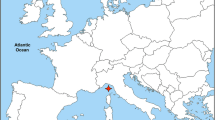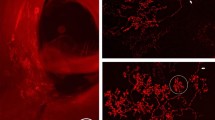Abstract
ELASMOBRANCHS have a well-developed system of large tubular sense organs, the Lorenzinian ampullæ1–4. In the dogfish, each ampulla consists of a bulb-like swelling, about 0.7 mm. in diameter, located deeply in the head of the fish, and a jelly-filled tube, several mm. long, that opens in a skin pore (see inset of Fig. 1). The ampulla is innervated by a bundle of 4–8 nerve fibres that end inside the swelling. Since the findings of Sand5 and Hensel6 that the stationary frequency of impulses discharged by the Lorenzinian ampulla has a high temperature coefficient (Q 10 = 2–3), the organ has been generally regarded as a thermo-receptor. But at that time, it was not yet known that not only thermo-receptors but also mechano-receptors may have such a high temperature coefficient without losing their mechano-receptor specificness7,8. The general morphology of the Lorenzinian ampulla suggests a mechano- rather than, a thermo-receptor function. In any event, its deep location in the head, and the relatively low thermal conductivity of the jelly of its tube, argue strongly against its being a thermo-receptor. In fact, Murray9 has recently shown in in situ experiments that probing of the ampulla pore with a bristle causes a brief change in the frequency of the nerve impulses discharged. In this communication evidence will be given that the ampulla is sensitive to pressure; it produces generator potentials which increase with the internal pressure of the ampulla.
This is a preview of subscription content, access via your institution
Access options
Subscribe to this journal
Receive 51 print issues and online access
$199.00 per year
only $3.90 per issue
Buy this article
- Purchase on Springer Link
- Instant access to full article PDF
Prices may be subject to local taxes which are calculated during checkout
Similar content being viewed by others
References
Malpighi, M. (1663), in “Marcelli Malpighii opera postuma” (Amstelodami, 1698).
Lorenzini, J., “Osservazioni intorno alle Torpedini” (Fireuze, 1678).
Peabody, J. E., Zool. Bull., 1, 163 (1897).
Dotterweich, H., Zool. Jahrbücher, 50, 347 (1932).
Sand, A., Proc. Roy. Soc., B, 125, 524 (1939).
Hensel, H., Pflügers Arch., 263, 48 (1956).
Ishiko, N., and Loewenstein, W. R., Science (in the press).
Loewenstein, W. R., J. Neurophysiol. (in the press).
Murray, R. W., J. Exp. Biol., 37, 417 (1960).
Katz, B., J. Physiol., 111, 261 (1950).
Loewenstein, W. R., and Rathkamp, R., J. Gen. Physiol., 41, 1275 (1958).
Edwards, C., and Ottoson, D., J. Physiol., 143, 138 (1958).
Cf. Grundfest, H., in “Evolution of Nervous Control” (Amer. Assoc. Adv. Sci., Washington, 1959).
Cf. Kuffler, S. W., “Harvey Lectures” (Academic Press, Inc., New York, 1960).
Author information
Authors and Affiliations
Rights and permissions
About this article
Cite this article
LOEWENSTEIN, W. Mechanisms of Nerve Impulse Initiation in a Pressure Receptor (Lorenzinian Ampulla). Nature 188, 1034–1035 (1960). https://doi.org/10.1038/1881034a0
Issue Date:
DOI: https://doi.org/10.1038/1881034a0
This article is cited by
-
Functional organization of the electroreceptive midbrain in an elasmobranch (Platyrhinoidis triseriata)
Journal of Comparative Physiology A (1986)
-
Stretch receptor responses to sinusoidal stimuli depend critically on modulation depth and background length
Biological Cybernetics (1985)
-
Investigation of the mechanism of temperature sensitivity of the electroreceptors of ampullae of lorenzini
Neurophysiology (1980)
-
Differential thermosensitivity and electric prepolarization of the ampullae of Lorenzini
Pfl�gers Archiv European Journal of Physiology (1976)
-
Effect of temporal and spatial temperature gradients on the ampullae of Lorenzini
Pfl�gers Archiv European Journal of Physiology (1974)
Comments
By submitting a comment you agree to abide by our Terms and Community Guidelines. If you find something abusive or that does not comply with our terms or guidelines please flag it as inappropriate.



